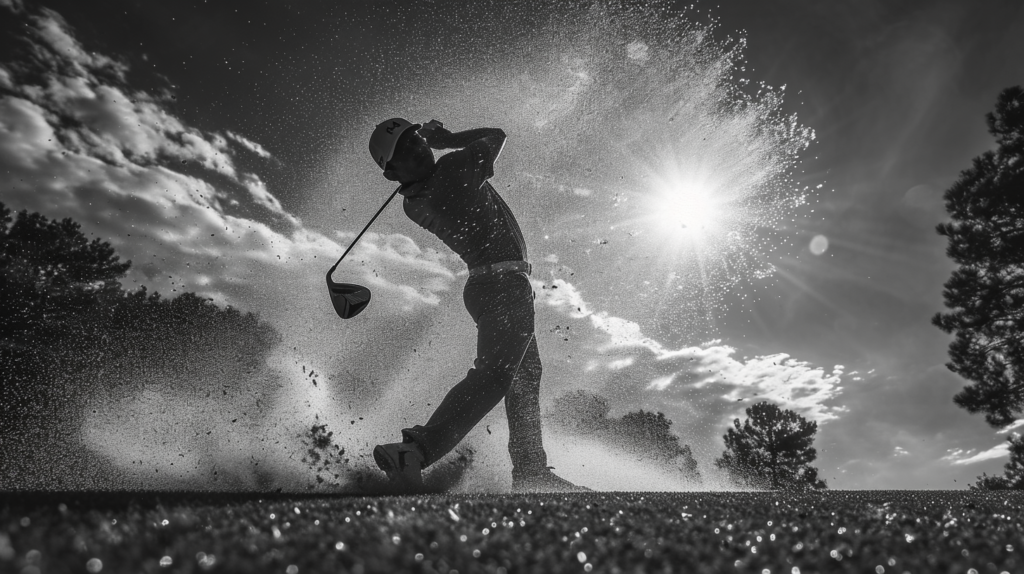Have you ever heard someone abruptly shout “fore!” on the golf course and wondered what it meant?
Yelling this odd term serves an important purpose – alerting others that an errant golf ball is headed their way.
Let’s dive in to understand when and how to properly call “fore” so we can keep all golfers safe.
What Does “Fore” Mean In Golf

Fore is a warning shout used in the sport of golf to alert other golfers that an errant shot is heading in their direction. The word itself is simply meant to grab attention so that people look up to see a ball flying towards them.
Yelling “fore” is an essential etiquette all golfers must observe to prevent injuries from struck golf balls.
When hit, golf balls can travel at extremely high speeds and cause serious harm if they hit other people on the course. Shouting fore warns all within earshot to take cover from an approaching ball.
It is usually yelled loudly and repeatedly by the golfer who hit the errant shot or others in the group. Proper use of the term and reacting appropriately after hearing it called out are important golfing safety practices.
When Should You Yell “Fore”

Golfers should yell fore anytime they hit a shot that has the potential to head towards other people. Common situations that require a warning shout include:
Sliced or hooked shots that curve significantly off the intended line. Since slices curve hard right and hooks curve hard left for right-handed golfers, these wayward shots often have the chance to travel towards other groups or areas where people may be standing.
Even if you are unsure whether your slice or hook will actually reach anyone, it is better to give the cautionary yell just in case.
Shots that carry much further than intended. Whether due to wind assistance, abnormal contact, or simple misjudgment, some golf shots end up gaining more distance. If these long shots appear headed for a green, fairway, or other location where others may be in range, fore should be promptly shouted.
Any shot pattern that may bring the ball unexpectedly close to others warrants a fore call. Since it is often difficult to judge precisely where an errant ball may end up, airing on the side of caution is wise.
If your ball heads even remotely near others, yelling fore is appropriate.
Fore should be shouted as soon as a golfer realizes their shot may be off target. Once contact is made, assessing ball flight begins. If a sliced or hooked pattern appears evident, fore should be yelled immediately without waiting to see where the ball lands.
Fast reaction time gives those in the ball’s path greater opportunity to take proper protective actions.
Who Should Yell “Fore”

The responsibility to shout fore lies with the golfer who hit the errant shot headed towards danger. However, others in that player’s group who see a concerning trajectory can also vocalize a warning.
Essentially, anyone who observes a ball heading where it should not go should yell fore.
Still, the obligation remains primarily on the person who mis-hit. They know what type of shot was attempted and can best assess if something went wrong requiring a fore warning.
Other members of the group should absolutely shout if they see trouble, but not rely on them to do so.
In most cases, the golfer making the errant swing initiates the fore alert. But observers downrange from the tee box or in front of an approach shot may actually detect danger first.
If you are in another location and see an approaching ball that players seem unaware of, by all means shout fore yourself. Protecting safety takes priority over whose responsibility it is to warn.
Relying only on the proper etiquette of the golfer who mis-hit is unsafe. While most would appropriately shout fore when necessary, heat-of-the-moment reactions may delay responses when focus locks onto the poor result rather than the hazard created.
Plus, newer players may not fully understand when fore is required. For these reasons, everyone must stay alert for themselves and others.
What To Do When You Hear “Fore”

Hearing someone else in the distance yell fore means you need to seek shelter promptly. Stop what you are doing and assess the situation first.
Try visually locating the ball in flight to gauge whether it poses an immediate threat to you. Once spotted, determine its height/trajectory to see if evasive moves or cover are required.
If the ball appears headed your way and time allows, get behind any cover you can find – a tree, golf cart, bag, etc. However, never take your eyes off the ball even when taking shelter in case you need to readjust.
If imminent impact seems likely with no time to hide safely, cover your head with both hands and duck. Protect your eyes and face at all costs while turning away from the ball’s path.
Crouching into a ball with hands shielding is ideal.
Either behind cover or hands-on head in a ducked position, carefully watch as the ball flies and lands. Wait until it stops rolling before standing up or resuming normal activities.
Making sure the situation is clear prevents prematurely emerging when another ball could strike.
Also verbally warn any others very close by after hearing fore yourself. Shouting something like “fore, take cover!” alerts nearby golfers possibly oblivious to the initial call and gives them precious reaction time too. Work together by relaying the danger.
Proper Etiquette For Yelling “Fore”

Shouting an effective fore warning relies on proper etiquette to maximize safety:
Volume: While using an urgent tone, yell loudly enough for your voice to carry a long distance. Sound waves fade over length so give full exertion to vocalizations.
Repeat shouting fore if the ball stays airborne to extend the audible range.
Clarity: Shout the actual word “fore” rather than just incoherent yelling. Using this unique golf-specific term clearly communicates a ball is heading someone’s way.
Yelling gibberish may fail to relay the same message effectively.
Sincerity: Never joke around by shouting fore if no actual danger exists just to scare someone as a prank. Doing so promotes ignoring real warnings in the future.
Save true fore calls only for authentic wayward ball situations.
Timeliness: Yell fore at the first indication trouble appears without hesitation. Early signalling allows more reaction time for those needing to take cover.
Delaying wastes precious seconds for them to protect themselves properly.
Apologies: If your ball lands very close to others or they need to take evasive action, always apologize afterward. Ask if they are okay while expressing remorse for putting them at risk, even if accidental.
Shouting fore appropriately when necessary and reacting properly after hearing the term called out represents essential golf course safety etiquette. Taking these warning signals seriously prevents injuries while showing respect for every golfer’s well-being.
Please yell fore loudly and clearly anytime wayward ball trouble arises so we all play safely!
Conclusion
Yelling “fore” when necessary and properly responding to its warning shows care for all golfers’ safety. Following proper etiquette keeps the game enjoyable for everyone while preventing avoidable harm.
By collectively committing to shout and take cover at the earliest signs of danger, we demonstrate the respect and attentiveness that makes golf great.



